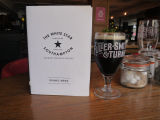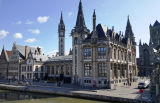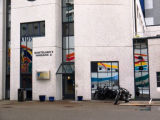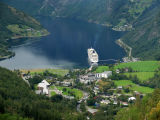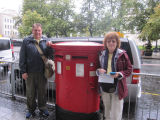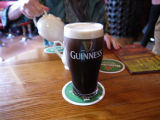Click on the round photo insert to see our photos
Ghent (/ɡɛnt/; Dutch: Gent [ɣɛnt] (About this soundlisten); French: Gand [ɡɑ̃] (About this soundlisten)) is a city and a municipality in the Flemish Region of Belgium. It is the capital and largest city of the East Flanders province, and the third largest municipality in Belgium, after Antwerp and Brussels.[2] The city originally started as a settlement at the confluence of the Rivers Scheldt and Leie and in the Late Middle Ages became one of the largest and richest cities of northern Europe, with some 50,000 people in 1300. It is a port and university city.
Amsterdam (/ˈæmstərdæm/, UK also /ˌæmstərˈdæm/;[10][11] Dutch: [ɑmstərˈdɑm] (About this soundlisten)) is the capital and most populous city of the Netherlands, with a population of 866,737 within the city proper, 1,380,872 in the urban area,[5] and 2,410,960 in the metropolitan area.[9] Amsterdam is in the province of North Holland.[12][13] Amsterdam is colloquially referred to as the "Venice of the North" due to its large number of canals which are a UNESCO World Heritage Site.
Bergen (Norwegian pronunciation: [ˈbærɡn̩] (About this soundlisten)), historically Bjørgvin, is a city and municipality in Hordaland on the west coast of Norway. At the end of the first quarter of 2018, the municipality's population was 280,216,[1] and the Bergen metropolitan region has about 420,000 inhabitants. Bergen is the second-largest city in Norway. The municipality covers 465 square kilometres (180 sq mi) and is on the peninsula of Bergenshalvøyen. The city centre and northern neighbourhoods are on Byfjorden, 'the city fjord', and the city is surrounded by mountains; Bergen is known as the 'city of seven mountains'. Many of the extra-municipal suburbs are on islands. Bergen is the administrative centre of Hordaland, and consists of eight boroughs: Arna, Bergenhus, Fana, Fyllingsdalen, Laksevåg, Ytrebygda, Årstad, and Åsane.
Geiranger is a small tourist village in Sunnmøre region of Møre og Romsdal county in the western part of Norway. It lies in the municipality of Stranda at the head of the Geirangerfjorden, which is a branch of the large Storfjorden. The nearest city is Ålesund. Geiranger is home to some of the most spectacular scenery in the world, and has been named the best travel destination in Scandinavia by Lonely Planet. Since 2005, the Geirangerfjord area has been listed as a UNESCO World Heritage Site. The Seven Sisters waterfall is located just west of Geiranger, directly across another waterfall called "The Suitor."[2][3] Norwegian County Road 63 passes through the village. Geiranger Church is the main church for the village and surrounding area.
Geiranger is under constant threat from landslides from the mountain Åkerneset into the fjord. A collapse could cause a tsunami that could destroy downtown Geiranger.
Reykjavík (/ˈreɪkjəvɪk, -viːk/ RAYK-yə-vik, -veek;[4] Icelandic: [ˈreiːcaˌviːk] (About this soundlisten)) is the capital and largest city of Iceland. It is located in southwestern Iceland, on the southern shore of Faxaflói bay. Its latitude is 64°08' N, making it the world's northernmost capital of a sovereign state.[a] With a population of around 128,793 (and 228,231 in the Capital Region),[3][5] it is the center of Iceland's cultural, economic and governmental activity, and is a popular tourist destination.
Reykjavík is believed to be the location of the first permanent settlement in Iceland, which, according to Landnámabók, was established by Ingólfr Arnarson in AD 874. Until the 19th century, there was no urban development in the city location. The city was founded in 1785 as an official trading town and grew steadily over the following decades, as it transformed into a regional and later national centre of commerce, population, and governmental activities. It is among the cleanest, greenest, and safest cities in the world.[6][7][8]
Belfast (/ˈbɛlfɑːst/ BEL-fahst; from Irish: Béal Feirste, meaning "mouth of the sand-bank ford",[11] Irish pronunciation: [bʲeːlˠ ˈfʲɛɾˠ(ə)ʃtʲə]) is the capital and largest city of Northern Ireland, standing on the banks of the River Lagan on the east coast of Northern Ireland. It is the 12th-largest city in the United Kingdom[12] and the second-largest on the island of Ireland. It had a population of 333,871 as of 2015.[2] Belfast suffered greatly in the Troubles: in the 1970s and 1980s it was reported to be one of the world's most dangerous cities,[13] with a homicide rate around 31 per 100,000.[14]
Dublin (/ˈdʌblɪn/, locally /ˈdʊb-/; Irish: Baile Átha Cliath[12] [ˈbˠalʲə aːhə ˈclʲiə; ˌbʲlʲaː ˈclʲiə]) is the capital and largest city of Ireland.[13][14] Situated on a bay on the east coast, at the mouth of the River Liffey, it lies within the province of Leinster. It is bordered on the south by the Dublin Mountains, a part of the Wicklow Mountains range. It has an urban area population of 1,173,179,[8] while the population of the Dublin Region (formerly County Dublin) as of 2016 was 1,347,359.[7] The population of the Greater Dublin Area was 1,904,806 per the 2016 census.[15]
Salsbury, Stonehenge, Windsor Castle and Heathrow Airport Pheasant Inn
